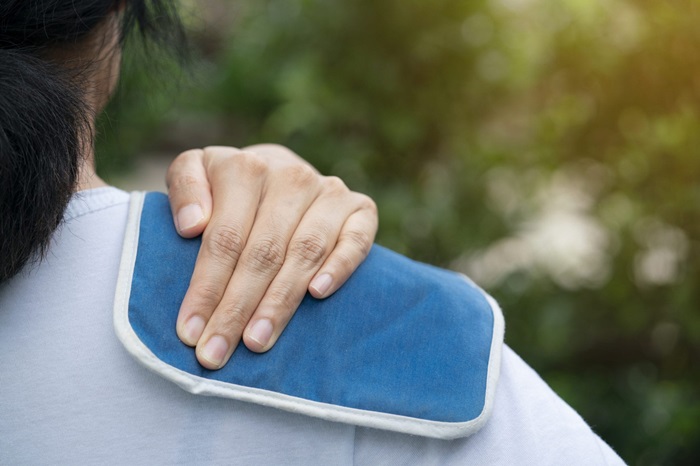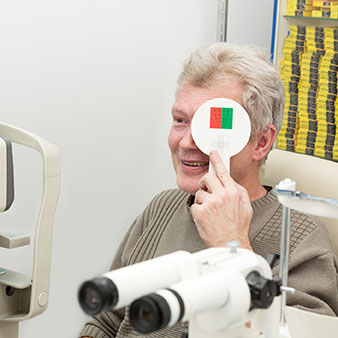When to Apply Ice Vs. Heat Packs

November 14, 2019
Sapna Rama, D.O. board certified in internal medicine, differentiates cold therapy from heat therapy and outlines the appropriate relief plans depending on your injury or pain.
What is cold therapy?
Cold therapy is used to reduce blood flow by constricting, or closing, blood vessels. As explained by Dr. Rama, cold therapy can ease pain caused within the first 72 hours of any acute injury, such as an ankle sprain or muscle strain.
During an acute injury, blood will respond with inflammation and increase blood flow to the area. “This increase in blood flow is what causes any swelling and pain,” Dr. Rama explains. “By applying cold therapy, such as ice packs, frozen gel packs or even ice baths, you can reduce the inflammation and pain and ultimately allow your body to heal.”
In addition to acute sprains and strains, what else can cold therapy be used to heal?
Dr. Rama says that cold therapy could be helpful for flaring joints caused by arthritis, gout flare-ups and even vascular headaches.
When should I absolutely not use cold therapy?
“You should refrain from using cold therapy for attempting to treat any chronic type of injury,” says Dr. Rama. Additionally, the expert warns that you should never apply cold therapy to open wounds.
“It is also not recommended for people with circulatory problems or neuropathic problems, such as diabetic neuropathy,” continues Dr. Rama.
What do I need to know about cold therapy?
Dr. Rama provided the following tips and guidelines for cold therapy:
- Never apply the ice directly onto the skin. You need to have a thin barrier—such as a towel or shirt—between the skin and ice, notes Dr. Rama. “Otherwise, you risk causing frost bite or damaging the delicate tissue of your skin,” she cautions.
- Ice should never be applied for more than 20 minutes. Dr. Rama cited studies suggesting that the body will have a negative response and dilate the vessels if applied any longer, causing more inflammation.
- Wait 40 minutes to 1 hour before reapplying. “Don’t fall asleep or keep it on for hours as this can prevent healing,” she warns.
- Cold, burning, aching and numbing feelings are completely normal. “You may experience these sensations—and trust that it is completely normal,” says Dr. Rama. “Despite any discomfort, try not to remove that ice because it really can help.”
What is heat therapy?
The role of heat therapy is to increase blood flow by dilating, or opening up, blood vessels. “The goal here is to increase pliability, flexibility and mobility of the muscles and joints,” elaborates Dr. Rama.
Individuals can use methods of dry heat, such as heating pads, dry heating packs or saunas, or moist heat, such as steamed towels or hot baths, to target the pain areas. “Moist heat is believed to be more effective and act more quickly,” says Dr. Rama. “But keep in mind the location of pain. If it is a small, localized area, heated gel packs may be best. If it’s a larger part of the body, though, steamed towels or hot baths may be more effective.”
When should I use heat therapy?
Dr. Rama notes that heat therapy is best for chronic issues, such as stiffness caused by arthritis, which bring about feelings of dull and achy pain. However, she also states that you can use heat therapy when you are exiting the acute phase of injury (typically post-72 hours) and entering the subacute phase.
“Listen to your body!” exclaims Dr. Rama. “If the area still appears inflamed and radiating with pain and redness, it is likely too early to apply heat therapy. But if you feel that you have transitioned, then change your therapy plan, too.”
What do I need to know about heat therapy?
Dr. Rama provided the following tips and guidelines for heat therapy:
- Regardless of the moist heat or dry heat method, heat therapy should be used for approximately 30 minutes.
- Use enough insulation. “Make sure that the heat source doesn’t overheat or burn the skin,” warns Dr. Rama.
When should I absolutely not use heat therapy?
“For any acute injuries such as muscle sprains, strains, knee injuries, fractures or dislocations, heat therapy is not advised,” shares Dr. Rama.
Similarly to cold therapy, heat therapy should also never be applied to open wounds and patients with circulatory problems should avoid, as well.
Why is it important to know the difference between using heat versus cold therapy?
“If you don’t use the right therapy at the right time to facilitate healing, you can sometimes make the problem even worse,” says Dr. Rama. “As always, though, make sure to consult with your doctor if you have any questions or have any concern with your health.”
Next Steps & Resources:
- Meet our clinical contributor: Sapna Rama, D.O..
- To make an appointment with a doctor near you, call 800-822-8905 or visit our website.
- VIDEO: When to Treat With Heat Vs. Ice
The material provided through HealthU is intended to be used as general information only and should not replace the advice of your physician. Always consult your physician for individual care.
Find a doctor near me
Clinical Contributors
Five Tips for a Healthier Workout

Three of our cardiologists share how to fit heart healthy exercise into even the busiest schedules.
Find a doctor near me

What is Vision Therapy—and How Does it Help?
Improve vision & quality of life with vision therapy. Treat blurry vision, eye strain, and more. Learn how vision therapy can help you.

Why Routines are Important for Mental Health
Maintain good mental health with daily routines. Dr. Solhkhah shares simple routines to reduce stress and anxiety. Learn more and schedule an appointment today.

8 Possible Causes (and Treatments) for Your Dizziness
Research shows that dizziness, vertigo and balance problems affect about 15 percent of U.S. adults each year.

